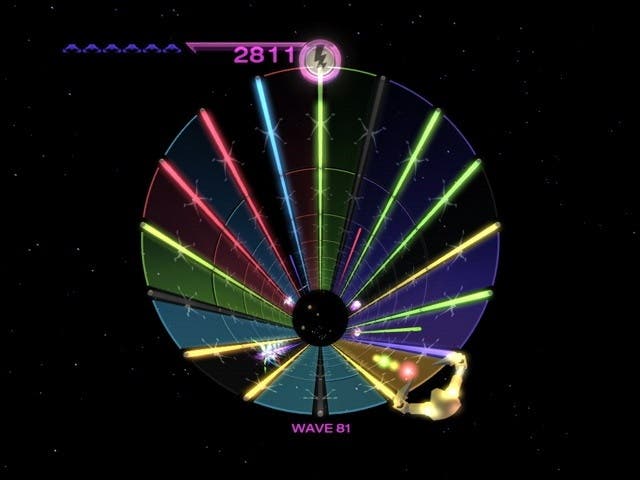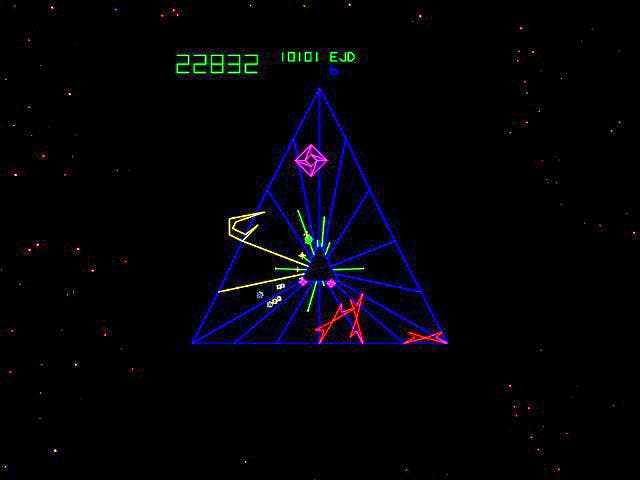Tempest
Storm warning.
This is not Space Giraffe.
Anyway, Jeff Minter is intrinsically linked to the Tempest franchise, having developed it for a number of platforms since David Theurer made it up in the early '80s. Minter's infamous one was Tempest 2000 for the Atari Jaguar. His evolution of the Tempest mechanics also gave us Space Giraffe - a game you either love like a brother or loath like a brother.
I fall into the latter camp. The game hidden in the depths of the wondrously psychedelic colours is fantastic, but the unforgiving difficulty level (synonymous with Minter's games) hammered one too many nails into the game's coffin. I adored the enhanced visuals, but found myself looking for the Nuon visualiser 'off' button that unfortunately wasn't available (and was even omitted from the subsequent patch) so I could actually play the game. Oh well.
Maybe the XBLA version of Tempest is the answer to my nightly prayers? Let's find out!
Produced by Atari in 1980, the first impression the arcade-goer had of Tempest was the game's housing - a triangular cabinet adorned with explosive interstellar artwork that screamed "Over here, look at me!" very, very loudly. The control panel, also covered in galactic art, contained a rotary spinner controller, a fire button, and the 'superzapper' button. This artistic extravagance has since made the Tempest cabinet a collector's dream, alongside the glow-in-the-dark Tron cabinet. [Talk about the game. - Ed]

In Tempest, the player directs a horseshoe-shaped craft around the outside edge of a playing area that's split into segments, with enemies marching from the middle of the screen towards you at the edge in neat alignment with said segments. Read that sentence again and look at the screenshot - bosh. By pressing the fire button, you can make your enemies dead, and smack down their bullets if they're firing any. Pressing the 'superzapper' button the first time will see all nasties and their weapons-fire destroyed. A second press has a more limited effect in that only one random enemy is destroyed. Further use of the 'zapper will prove fruitless until the next level.
There are five different enemies in total to contend with, and each has a unique style of descent - their primary objective being simply to destroy you before being destroyed. Getting to know your enemy will ultimately help you through the 99 levels Tempest has to offer.
XBLA Tempest is a bang up-to-date version of the game promising accurate, un-tampered arcade gameplay with bells and whistles bolted on for good measure. If you wander over to Eurogamer TV you'll see the game features in our Top 50, pre-1986 arcade list. One can deduce, therefore, that us Eurogamer chappies hold this game in high regard. Well, the original arcade version anyway.
Stainless' conversion of Tempest for XBLA comes in two flavours: the original arcade version and, as we've come to expect from its retro remakes, an 'enhanced' version that includes a modern reskin of the original visuals. Looking at the original version of Tempest first, it's pleasing to report that everything looks and plays like you remember from the days when a pocketful of 10p coins gave you a whole afternoon of entertainment in the arcade.

The first glaring issue with Tempest on XBLA soon hits home though. As you move your craft around the playfield with either the analogue controller or the d-pad, precision of movement goes out of the window with your craft over-shooting the mark, often resulting in a loss of one of your limited lives. The game was designed with a 'spinner' in mind and the 360 gamepad falls way short as a substitute. It's hit and miss, which doesn't work. On many an occasion, the controller will move the craft one to two segments on its own - "look mum, no hands!"
The look of the original game has dated terribly, though, so you will soon find yourself looking for the enhanced option on the settings menu to whisk you into graphical and aural splendour, maybe.
Prepare to be disappointed on both counts. While the graphics are an improvement on Tempest's original artwork, they often get in the way of the game mechanics - just as they do in Space Giraffe. Stealth bullets, hidden by the graphical splendour, way too often find their target, taking another of your lives. Frustration quickly sets in. Sound-wise, Tempest blurts out the minimum of spot effects. Where is the stirring title soundtrack so missing on many of these retro remakes? Where are the earth-shattering explosions and the satisfying dying screams of enemies blown to smithereens?
Another 'enhanced extra' is Stainless' now-obligatory Throttle Monkey mode. It is well-known that Tempest is a game that already truly tests the reflex reactions of the player - lives can be and are lost with the slightest lapse of concentration or a mis-judged moved of your craft - but Throttle Monkey accelerates the game several-fold, giving you the Tempest experience in 10 seconds. Well, that's how long it will take for you to lose all your lives and see the game-over fanfare, anyway. It feels like a waste of time.

Achievement points are there for the taking, obviously. Unfortunately they are all linked to the enhanced version of the game, including one within Throttle Monkey mode where 100,000 points gets you a measly 20 gamerpoints! It would have been nice to have one or two Achievements linked to the original form of the game for us oldies.
Anyway, I tried to enjoy Space Giraffe and gave it a good play before giving up on it, and I had hoped that the remake of Tempest would have resolved the issues I had had with Minter's game. But with a poor graphical upgrade, poor audio and an impossible 360 controller experience, you might as well give your 400 Microsoft points away, irrespective of how tinted your glasses are with rose petals. If you want to see what this sub-genre really has to offer, then look for Minter's Tempest 2000 on the Atari Jaguar/SEGA Saturn/PC, or Tempest X on the first-generation PlayStation. Or, for the richer readers out there, buy the original arcade machine.
